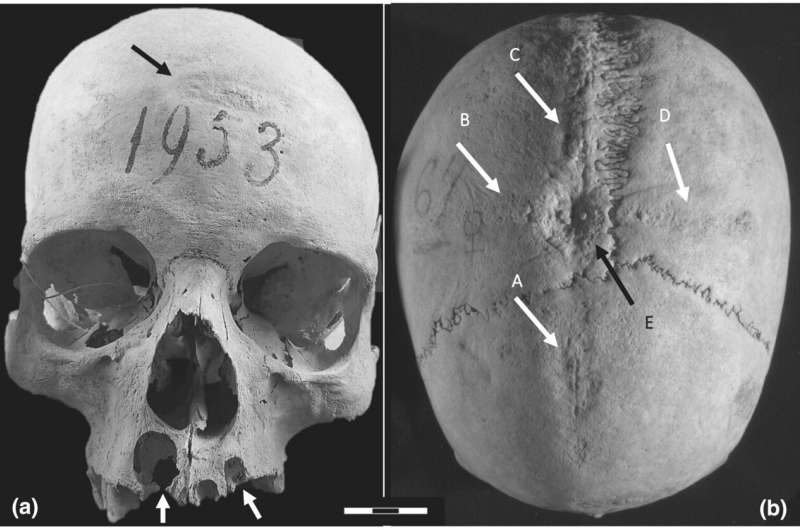February 22, 2023 report
This article has been reviewed according to Science X's editorial process and policies. Editors have highlighted the following attributes while ensuring the content's credibility:
fact-checked
trusted source
proofread
Volunteering for cranial surgery in medieval Italy

Sometime in the period from the 6th to the 8th century, a woman willingly underwent surgery to scrape a hole into the top of her skull. The procedure must have gone well, at least well enough for her to survive and to try it several more times.
A multinational group of researchers from the U.K., Spain, France, Italy and the U.S. discovered the unusual bone modifications while conducting detailed observations on remains excavated from the Longobard cemetery of Castel Trosino in central Italy. The paper, "An unprecedented case of cranial surgery in Longobard Italy (6th–8th century) using a cruciform incision" is published in the International Journal of Osteoarchaeology.
The skull was in well-preserved condition and cut marks were visible on inspection. Standard physical anthropology protocols were used to determine the sex and age of the remains based on morphology, which revealed she was a female, around age 50.
Microscopic and CT scan analyses further revealed signs of at least two sets of scraping marks with metal surgical tools. Both healed and unhealed defects in the bone indicate that the woman received multiple distinct rounds of skull modification.
In one location, researchers found significant signs of healing, suggesting that the surgery was a success, or at least that the patient survived the procedures for more than six months.
Scanning electron microscopy analysis shows that the bone-scraping traces on a second location on the skull did not heal, and so must have taken place right around the time of death. This suggests that the second round of modifications may not have ended as well as the first.
The grave site of the woman was shared with a male individual, likely her spouse, and was in a central location within a cemetery of Longobard elites. Grave goods included a bronze brooch, comb, and gold filaments, indicating that the occupants were of wealthy means.
Taking into consideration the woman's position of privilege, both before and after death, the researchers have ruled out the procedure as being a form of punishment or an unwanted procedure forced upon an unwilling test subject, but rather a voluntary attempt to receive a therapeutic outcome.
According to the study, "These were planned, and an operator intentionally conducted recurring bone modifications."
The exact reason for the elective surgery is difficult to discern. Attempts to determine a specific pathological condition were inconclusive. While there are plenty of reasons a woman of medieval means might desire a hole in her skull, none of them are forensically obvious here.
Trepanation, the act of scraping holes into a human skull, is known to have been practiced in medieval times. There are examples of possibly ceremonial trepanning from other regions, most notably Hungary, where, interestingly, the Longobards resided before many immigrated to Italy. However, the researchers do not believe this is a shared or held-over cultural act as the site shows a high degree of assimilation with the Byzantine culture of Castel Trosino.
Hundreds of burials were recovered from the Castel Trosino site when it was discovered over 120 years ago, but only 19 skulls are currently available for assessment. Of these, only one shows signs of skull modification, so the researchers are unable to determine whether this was a more widespread procedure.
This is not the first example of medieval medical expertise to be found in Italian Longobard graves. A previous paper published in 2018, "Survival to amputation in pre-antibiotic era: a case study from a Longobard necropolis (6th–8th centuries AD)," led by Dr. Ileana Micarelli, McDonald Institute for Archaeological Research, University of Cambridge (who is a co-lead author on the current paper) reported on an individual with a prosthetic blade for a hand. The hand had been neatly amputated and the bones around the prosthetic blade showed signs of healing and prolonged use.
The history of the Longobards is of a primarily Germanic warrior culture that once ruled portions of modern-day Austria and Hungary before invading and eventually settling in Italy after the fall of the Roman Empire. A correlation of surgical expertise with Longobard warrior culture may reflect a knowledge formed from experience and medical necessity, not unlike that shared by athletes and sports medicine today.
More information: Ileana Micarelli et al, An unprecedented case of cranial surgery in Longobard Italy (6th–8th century) using a cruciform incision, International Journal of Osteoarchaeology (2023). DOI: 10.1002/oa.3202
© 2023 Science X Network





















